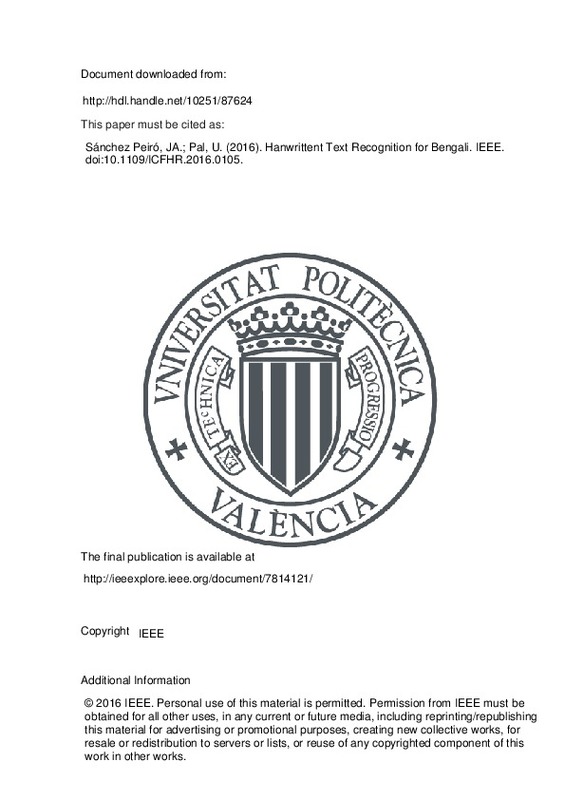JavaScript is disabled for your browser. Some features of this site may not work without it.
Buscar en RiuNet
Listar
Mi cuenta
Estadísticas
Ayuda RiuNet
Admin. UPV
Hanwrittent Text Recognition for Bengali
Mostrar el registro sencillo del ítem
Ficheros en el ítem
| dc.contributor.author | Sánchez Peiró, Joan Andreu
|
es_ES |
| dc.contributor.author | Pal, Umapada
|
es_ES |
| dc.date.accessioned | 2017-09-20T10:41:42Z | |
| dc.date.available | 2017-09-20T10:41:42Z | |
| dc.date.issued | 2016 | |
| dc.identifier.issn | 2167-6445 | |
| dc.identifier.uri | http://hdl.handle.net/10251/87624 | |
| dc.description | © 2016 IEEE. Personal use of this material is permitted. Permission from IEEE must be obtained for all other uses, in any current or future media, including reprinting/republishing this material for advertising or promotional purposes, creating new collective works, for resale or redistribution to servers or lists, or reuse of any copyrighted component of this work in other works. | es_ES |
| dc.description.abstract | Handwritten text recognition of Bengali is a difficult task because of complex character shapes due to the presence of modified/compound characters as well as zone-wise writing styles of different individuals. Most of the research published so far on Bengali handwriting recognition deals with either isolated character recognition or isolated word recognition, and just a few papers have researched on recognition of continuous handwritten Bengali. In this paper we present a research on continuous handwritten Bengali. We follow a classical line-based recognition approach with a system based on hidden Markov models and n-gram language models. These models are trained with automatic methods from annotated data. We research both on the maximum likelihood approach and the minimum error phone approach for training the optical models. We also research on the use of word-based language models and characterbased language models. This last approach allow us to deal with the out-of-vocabulary word problem in the test when the training set is of limited size. From the experiments we obtained encouraging results. | es_ES |
| dc.description.sponsorship | This work has been partially supported through the European Union’s H2020 grant READ (Recognition and Enrichment of Archival Documents) (Ref: 674943) and partially supported by MINECO/FEDER, UE under project TIN2015-70924-C2-1-R. | es_ES |
| dc.format.extent | 6 | es_ES |
| dc.language | Inglés | es_ES |
| dc.publisher | IEEE | es_ES |
| dc.rights | Reserva de todos los derechos | es_ES |
| dc.subject | Hanwrittent Text Recognition | es_ES |
| dc.subject | HMM | es_ES |
| dc.subject | n-grams | es_ES |
| dc.subject | MPE training | es_ES |
| dc.subject.classification | LENGUAJES Y SISTEMAS INFORMATICOS | es_ES |
| dc.title | Hanwrittent Text Recognition for Bengali | es_ES |
| dc.type | Comunicación en congreso | es_ES |
| dc.identifier.doi | 10.1109/ICFHR.2016.0105 | |
| dc.relation.projectID | info:eu-repo/grantAgreement/EC/H2020/674943/EU/Recognition and Enrichment of Archival Documents/ | es_ES |
| dc.relation.projectID | info:eu-repo/grantAgreement/MINECO//TIN2015-70924-C2-1-R/ES/CONTEXTO, MULTIMODALIDAD Y COLABORACION DEL USUARIO EN PROCESADO DE TEXTO MANUSCRITO/ | es_ES |
| dc.rights.accessRights | Abierto | es_ES |
| dc.contributor.affiliation | Universitat Politècnica de València. Departamento de Sistemas Informáticos y Computación - Departament de Sistemes Informàtics i Computació | es_ES |
| dc.description.bibliographicCitation | Sánchez Peiró, JA.; Pal, U. (2016). Hanwrittent Text Recognition for Bengali. IEEE. https://doi.org/10.1109/ICFHR.2016.0105 | es_ES |
| dc.description.accrualMethod | S | es_ES |
| dc.relation.conferencename | 15th International Conference on Frontiers in Handwriting Recognition (ICFHR 2016) | es_ES |
| dc.relation.conferencedate | October 23-26, 2016 | es_ES |
| dc.relation.conferenceplace | Shenzhen, China | es_ES |
| dc.relation.publisherversion | http://ieeexplore.ieee.org/document/7814121/ | es_ES |
| dc.type.version | info:eu-repo/semantics/publishedVersion | es_ES |
| dc.relation.senia | 320614 | es_ES |
| dc.contributor.funder | European Commission | es_ES |
| dc.contributor.funder | Ministerio de Economía y Competitividad | es_ES |
| dc.contributor.funder | European Regional Development Fund | es_ES |







![[Cerrado]](/themes/UPV/images/candado.png)

